

A PASSAGE OF AN ARTIST
THRU TIME AND SPACE
by Popoy Castañeda
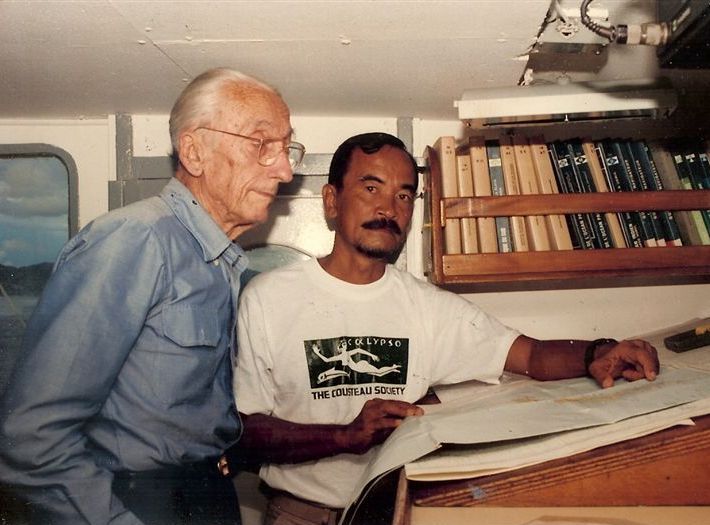
Popoy, the diver and guide, and the legendary Jacques-Yves Costeau study Palawan's hydrographic chart.
[See: A Betan's Journey Thru Time and Space, in Memoirs & Reminiscences]
Part 3 -
The Return of the Americans and the End of World War II
The column of tanks and armored vehicles soon drew abreast of our house and we
saw sitting on the turret of the leading tank a Filipino with the Philippine
flag draped around his shoulder and brandishing a submachine gun. He waved at us
and Tio Gracing waved back and shouted ‘’Pempe’’! He was an acquaintance and
movie star Jose Padilla Jr., a known guerilla leader. The armored column moved
fast and then came the vehicles pulling artillery and they occupied and set up
their cannons on the school ground across us. Soon we heard the sound of a
firefight coming from the south where the column was going. The artillery
battery started firing their cannons and they would be at it the whole night
and the whole day intermittently. That night the Americans came there was
excitement and fear for every one especially my aunts and Lola Loleng. Together
we spent a sleepless night in our air raid shelter praying.
Morning came and more soldiers came and set up a kitchen at the school building
which formerly housed the Kempetai. In a short while an American soldier was
soon conversing with Tatay who eventually invited him in the house. The
sergeant's name was Lance and was the commander of the tank dug inside of our
house. Tatay sketched him and the next morning the sergeant came with gifts of
canned goods, corned beef, vienna sausage, etc. Then Tatay with his sketch book
went across the street to the soldiers manning the Battery. He came back back
with a lot of canned food from the soldiers in exchange for the sketches he made
for them - Spam, vienna sausage, army fatigue, tins and combat rations complete
with chewing gums and cigarettes.
But there was danger for the Japanese were firing back at the US Battery and we
soon learned to be wary of the incoming enemy rounds which had the sound of
rustling dry leaves. Lucky for us the Japanese artillery never found their
target and just succeeded in gouging out holes on the school yard and Calle Juan
Luna. Soon after Kuyang Erning de Leon came with news from the family in
Palanyag and about the situation in the heart of the city, about the intense and
fierce firefights, the massacre of civilians and the holdouts at the Spanish
City of Intramuros. The family had returned to Palanyag and Kuyang Erning came
to bring news and to ask us when we were going back home. The next day Kuyang
Erning returned to Palanyag with his younger sister, Ate Telly. A week later
things seemed to be quieting down and returning to normal. Tatay told me that
Kuyang Erning particularly was sent to Gagalangin to take me back and told me to
put a few things that I needed in my schoolbag, say goodbye to my cousins and
Lola. By the next day we took off.
Tatay and I started out for Palanyag with the lifting of curfew at daylight. We
walked to the corner of Juan Luna and Solis Streets where we took a calesa to
Blumentritt market. From there at Blumentritt we dropped by at Tatay’s cousins
where we spent the rest of the morning exchanging news. Tatay was also able to
get film for his camera from his cousin Fabing Rojas. After an early lunch we
proceeded to walk to Calle Requesens where Nanay’s brother, Ninong Gusto ( Dr.
Augusto Gregorio Sr), resided. We walked taking care on our way because of the
damages on the structures incurred during the battle to capture the city. We
were warned to be wary of land mines and unexploded ordinances. We could not
pass on Rizal Avenue because the US Army had not opened it for civilian traffic.
Tatay was taking photos since his cousin Fabing, who worked at Kodak Philippines
gave him film for his camera, and making sketches of the ruins and rubbles. So
what used to be a half hour walk took us 2 hours. It was late afternoon when we
reached Ninong Augusto's apartment where Tatay spent most of the evening
exchanging stories about the Liberation. Ninong Augusto gave us more updates
about the fighting still raging in Intramuros where the Japanese were holding
out. Since he was a doctor at the Santo Tomas University Hospital where the
seriously wounded were being sent he was also able to arrange for an attendant
of the hospital (I forgot his name but I think he was the attendant who married
Inday, the maid who took care of Aurita and Junior) to go with us half way to
Pandacan where boats were available to ferry you across the river and where army
trucks were available to take people south to Baclaran.
We were able to start very early since Ninong Augusto had a curfew pass. We
walked to the hospital where the attendant was waiting for us. Soon as curfew
was off we started our walk. The attendant was going with us a far as Pandacan
where boats ferried civilians across the Pasig river since all bridges were
destroyed by the Japanese. Again we hade to take a circuitous route and surely I
was slowing down the progress of our walk. Tatay and our companion had to carry
me piggyback every now and then. It was was about 11 in the morning when we
reached the crossing where we parted ways. The attendant was going home to Pasig
and we were going south. We crossed on an outrigger banca paddled by a boatman,
similar to the boat used at La Huerta by people from Santo Niño to cross the
river to go to the market. After the crossing we ate our lunch made by Ninang
Nita of rice and corned beef, After lunch we queued up for the Army 6x6 truck
taking the people south as far as the Nichols Air Base, which is in Baclaran.
(Tatay had a new US Army watch given by Ninong Augusto.) Later our truck came
and when we boarded there were no seats. Everybody was standing up and soon we
were on our way. Along the way we saw the ravages of war. We even caught glimpse
of a Japanese corpse.
The trip took almost an hour since we could not speed up. We were dropped off at
Baclaran where we queued in again for a ride south. It didn't take long when we
got a ride on a small truck called a weapons carrier going to their base which
was at the St. Andrews School ground (now Saint Paul College). The driver was an
army cook who was very friendly and even introduced himself, Johnny. We soon
reached Dongalo and there we queued up to cross the pontoon bridge since the
Japanese blew up the bridge. Midway through the bridge we saw Tio Rasing, almost
unrecognizable in combat fatigues, carrying a paratrooper’s carbine. (The Tio
Rasing I used to know looked different, quiet, always smiling). Directing the
bridge traffic at the La Huerta side he laughed when he saw us and shouted and
waved at Johnny, who we found out was a family friend. We got off at the Plaza
with Johnny telling Tatay he would see him soon.
A few steps took us to M.H. del Pilar. It was crowded with vehicular traffic.
Apparently military vehicles had the exclusive use of the South Road from Las
Piñas to La Huerta. Civilian traffic had to pass thru the inner streets and at
La Huerta there was a check point manned by the guerillas just in front of our
house. A few more steps and we were at the gate which to our surprise was
guarded by two guerilla sentries. They were local boys who knew Tatay. One even
knew me and ran upstairs to announce our arrival. A the foot of the stairs we
noticed was a stack of rifles and the sala was full of men listening to
instructions from their officer who was introduced to Tatay as Col. Jaime
Ferrer. I noticed Tio Jose who was busy dressing the wound on the shoulder of a
guerilla who was laying down at the wide bench by the front window. The
guerilla, Mang Pico, was wounded, Col. "Jim" Ferrer proudly explained, during
the firefight in the capture of Nichols Airbase 5 days ago where the local
guerilla unit, the Hunters ROTC, took a major part and where Tio "Joe" Jose
played a critical part when he was able to pinpoint a hidden machinegun
implacement blocking the progress of the assault. Tio Jose was there as a medic.
The American officer gave Tio Jose a paratroopers carbine in gratitude.
The house apparently was the operating base of the guerillas of the Hunters ROTC
unit who were assigned to manage the town before civilian authorities could be
organized and established. Our arrival stirred up excitement on the household
and Tatay was busy answering questions about Nanay and Lito. Soon it was Angelus
signalled by the church bell of the St. Andrew Church. It was also the signal
for the stream of thousand of bats flying out of their roost in the cavernous
ceiling of the ancient church. It was a common sight then when the church bells
pealed the Angelus that the bats awakened and flew out in the nocturnal hunt for
food. They flew out in a continuous steam that lasted for half an hour or so.
Soon Kuyang Nil and Tio Rasing arrived and Auntie Auring took my things which I
was carrying in a hand-me-down school bag from Kuyang Nil. Then I had to kiss
all the elders' hands for Angelus blessings. Dinner was served with Col. Ferrer
at the head the table. Then I asked the question - "Where is Tio Tabing"? Col.
Ferrer in a very kind voice told me that he was still on duty at the army camp
and would be home soon enough.
Supper was just being cleared from the table when Johnny, the mess sergeant,
came with a can of ice cream from the army mess. Soon everyone including the
sentries ran downstairs to get their share. Johnny was also familiar with Col.
Ferrer and they seemed to be sharing a story and laughing at a joke. We moved to
the sala where Kuyang Nil and Johnny started playing on the piano. The story was
that they met when Kuyang Nil who played the piano was playing jazz when Johnny
passing by on his truck heard him and went up to see and meet Kuyang Nil. Johnny
was an avid jazz musician back in the States. (Kuyang Nil or Nilcar Hallare*,
the son of Dr. Marcelino Hallare, joined the Lord late last year. He was a
resident of Daly City, California USA. He and I were raised by Auntie Auring
Leonore de Leon. Kuyang Nil, a graduate of the University of the Philippines
College of Business Administration, worked with computers at the Bank of America
in San Francisco. He played the piano at The Curtain Calls, a jazz joint in San
Francisco in the evening. He was also a very good photographer and maintained a
hole in the wall photoshop in one of the side alleys along Powell Street. He was
a devil on the keyboards).
*Web note: Nilcar 'Nil' Hallare is UPD batch early 50's, though he is unlisted in the UP Beta Sigma Unified Directory. His son, Ferdinand 'Ferdz' Hallare, is UPD'91.
[This photo is posted in UPBSI website, Picture-an 1]
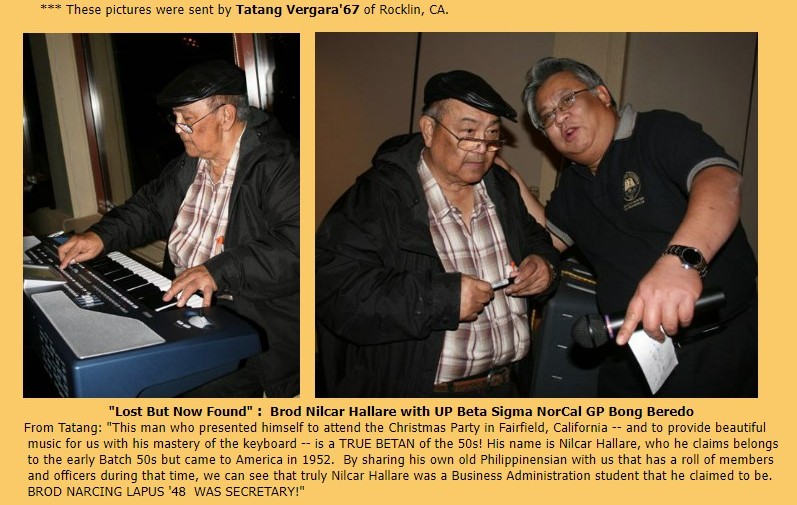
[This photo is posted in UPBSI website, Picture-an 4]
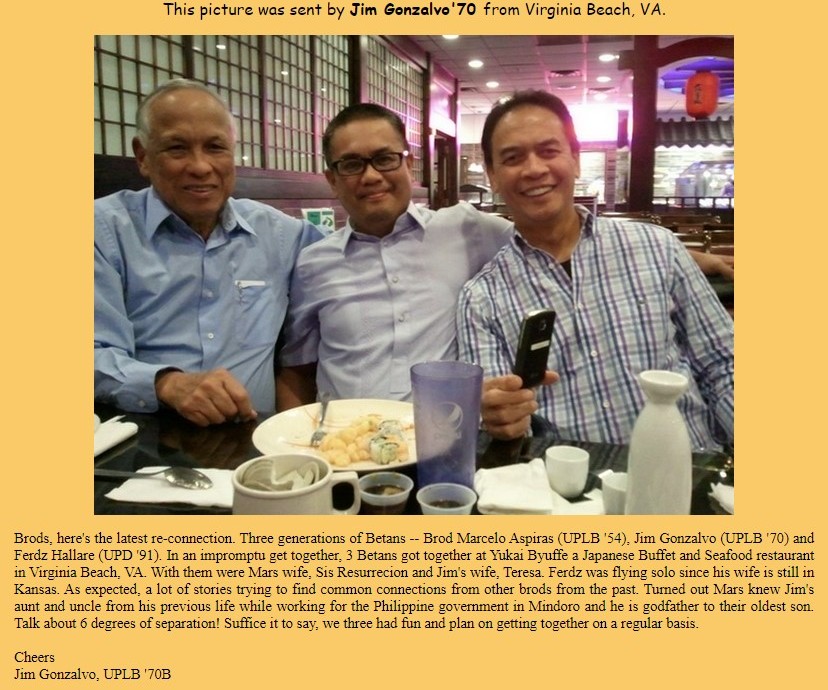
Auntie Auring took me to the bedroom to sort out the few things I had in my schoolbag: 2 pairs of red shorts (available on Sundays at the market at 1.00 Php, made in Binakayan), a khaki short for going to mass, 1 white t-shirt, a Superman sweatshirt, 2 white singlets, and a toothbrush. I had my slingshot with a small sock with round pebbles, my homemade diving goggles and a Boy Scout knife, a gift from Tatay. Tatay came in and told me he was leaving very early the next morning with Tio Rasing as escort. By that time the boys in the sala were dancing to either Kuyang Nil or Johnny’s piano playing. Despite my excitement I was soon asleep. I was rudely awakened by the sound of automatic gunfire and the area near the river at he back of San Nicolas chapel was lit up with flares and tracer bullets. We had to go down to the air raid shelter under the comedor. In a few minutes the firing ceased and soon the report came that it was a false alarm. A dog, for unknown reason, was swimming across the river which triggered the firing.
We went back upstairs after the all clear siren sounded. I woke up late and
Tatay had already left with Tio Rasing for Gagalangin. I easily regained
acquaintances with my playmates and it just took the whole day for me to be at
home again. This time we learned to play with new and dangerous toys. Just
lighting up fires at one time we even managed to detonate a Japanese potato
masher hand grenade. Often we just fired rifle rounds by punching the primers
with nails. We also learned to make necklaces of the bullets. (The amusement for
those toys soon stopped when a 12 year boy from Santo Niño, then called Ibayo,
was killed and 2 or 3 were hospitalized when a 30-mm mortar round exploded while
they were tinkering with it). I earned a session with the bamboo fence slats from
Lola Tina when it was found out I was one of the boys often seen playing with
live ammunition.
In the meantime the question of the absence of Tio Tabing remained unanswered.
Everyday I saw Lola Juana crying in front of the altar of the Sacred Heart and
also the old women praying with her in the afternoon. Even I was occasionally
asked if Tio Tabing was home already. Tio Tabing was a major of the Hunters ROTC
guerilla unit that was operating on the western slopes of the Sierra Madre
mountains between the provinces of Bulacan and Rizal. He commanded a unit
responsible for the liquidation of top Japanese officers and his nom de guerre
was Major de la Rama..There were news of him being killed in action. Earlier he
was supposedly killed when the US submarine resupplying the guerillas in
Infanta, Quezon was attacked by Japanese planes. Another was he was killed in
action in a firefight with Japanese troops in the town of Norzagaray. Hopes went
up when Col. Terry Adevoso, the command of the Hunters ROTC guerilla regiment,
came in with the news that Major de la Rama’s unit was attached to a US Army
unit pursuing Gen. Yamashita thru the Sierra Madre. Weeks passed and still no
one came home and the rumor came again that he was killed in action in a
firefight with a rear guard unit of Gen. Yamashita. Everybody seemed to have
accepted this version of story and the town had given a ceremony honouring him
and calling him a hero. The prayer novena for the dead for him was finished and
we seem to have accepted his demise. In the same week my Tatay, Nanay & brother
Lito came fetched by Tio Rasing and Lolo Camilo in his caretela.
It was a very gloomy afternoon because it had been raining off and on. Lola
Juana was in the sala talking with Nana Toria, Lola Cilia, Auntie Orang and Lola
Tina (Justina Santos). It was quiet except for the patter of raindrops on the
nipa roof when suddenly there was shouting along M.H. del Pilar Street I was in
the bedroom pretending to sleep when it started then the old folks at the sala
were shouting and running downstairs thinking fire. I ran behind Auntie Auring
and when I reached the bottom I saw a tall figure in uniform with the rank
insignia of a gold oak leaf of a major. The major was embraced by Lola Juana and
Auntie Orang. He was sunburned tarnished with jaundice of malaria. It was Tio
Tabing or Major Oscar de la Rama He was grim-faced trying to calm down
everybody. Behind Tio Tabing were his companions, a Filipino lieutenant and 2
other soldiers. One was wearing shorts and looked like a Japanese. I noticed the
hunting knife and .45 cal pistol on his utility belt. He was also carrying the
army haversack I presumed belonged to Tio Tabing.
The cluster of Tio Tabing and Lola Juana went upstairs and we took the back
stairs. It was chaotic upstairs with women crying - Lola Juana, Tina, Lola
Cilia, Auntie Orang. Everybody was trying to speak. Then Tio Tabing started to
speak and the crowd quieted down and listened to him talk. His unit was attached
to a unit of the US Army pursuing Gen. Yamashita. When they reached the
foothills of the Cordilleras in Nueva Vizcaya they were relieved by another
guerilla unit. Then they were assigned to sweep the lower western slope of the
Sierra Madre for Japanese stragglers up to Tanay. Rizal. They made the sweep and
on this operation they captured and had taken prisoner a Taiwanese conscript. It
was then and only then were they allowed to return to camp and eventually given
leave. The Japanese-looking person turned out to be a Taiwanese conscripted in
the Imperial Army and defected to the unit of Major dela Rama. The other
guerilla officer was a lieutenant, Totoy Samaniego.
That night there was a continued stream of visitors and luckily Col. Jim Ferret
came and and quieted down the revelers to give Tio Tabing and the family
rest. The homecoming of TioTabing completed and provided reason for a homecoming
and thanksgiving on Lola Juana’s birthday on June 24, St. John the Baptist’s
feast day. Concurrently Tio Jose with Miss Aida Gopez, the cathechist who was
giving me a daily cathechism lesson to prepare me for Holy communion, agreed and
decided that I was ready to receive my first communion and scheduled it on June
24. The day was also the anniversary of the enthronement of the Sacred Heart of
Jesus in the De Leon household. The Feast Day of St. John the Baptist was a
special day for Palanyag and the people celebrated it by getting wet and seeing
to it that everybody got wet. Nobody could get out in the street and stay dry.
We had the Thanksgiving mass with my first communion early to avoid getting wet.
We had a photograph taken of the whole family. It was a whole day celebration
including a few hours on the beach, a lunch with lechon courtesy of the Pascuals
of Nasugbu, Batangas and the special spaghetti of Auntie Orang Feliciano made
with chicken, chorizo de bilbao and vienna sausage. In the afternoon to cap it
off was the Rosario Cantada in honor of the Sacred Heart of Jesus enthronement
at the De Leon domicile.
In a few more months Gen. Yamashita surrendered and in another month or so the
war ended with the atomic bombing of the Japanese cities of Hiroshima and
Nagasaki. Gen. Tomoyoki Yamashita, the Tiger of Malaya, was executed and hanged
at Los Baños (now the campus of the University of the Philippines). Tio Tabing
and Tio Rasing were soon honorably discharged from their military service and
returned to civilian life.
[These are online photos]
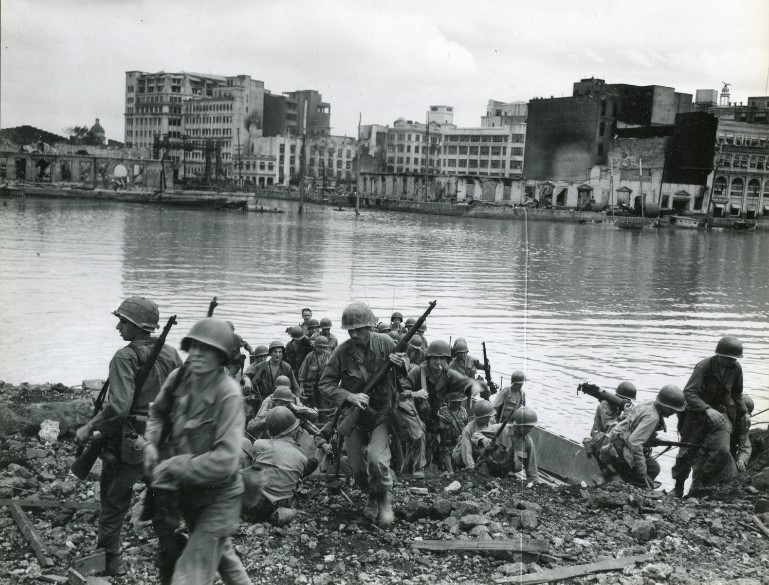
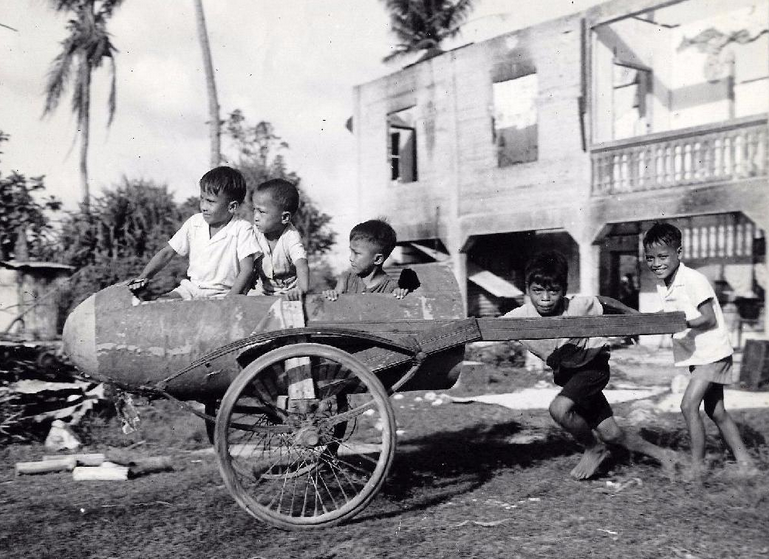
THE END
Links:
o Part 1 - My Life in La Huerta
Back ---> Memoirs & Reminiscenses)